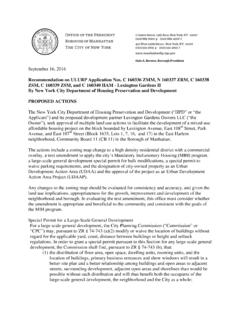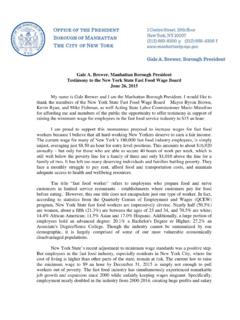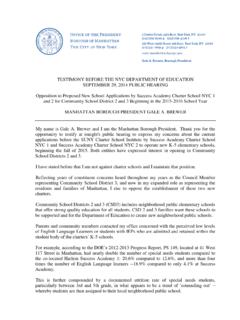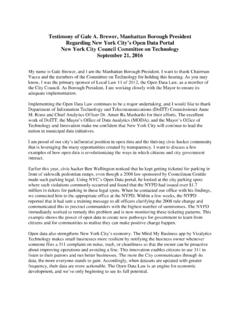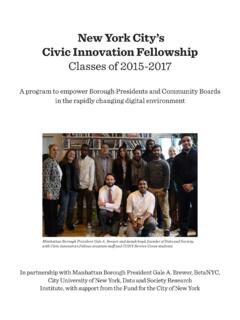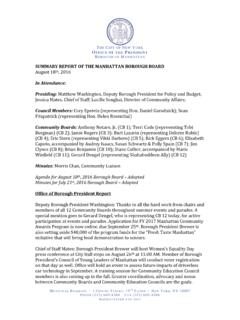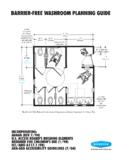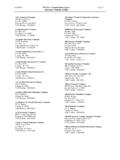Transcription of Gale A. Brewer, Manhattan Borough President …
1 gale a . Brewer, Manhattan Borough President testimony for the New York City Council Committee on Environmental Protection November 12, 2015 My name is gale a . Brewer and I am the Manhattan Borough President . I would like to thank Chair Constantinides and the members of the Committee on Environmental Protection for the opportunity to testify today. Downtown Manhattan Heliport handled 56,085 sightseeing helicopter flights in 2014. It is no wonder that oppressive, disorienting helicopter noise has become an ever-present part of life for many of our constituents. As Council Member, I worked with the New York City Economic Development Corporation (EDC) and my colleagues at the Federal, State and City levels to come up with the helicopter sightseeing plan, released April 29, 2010, that eliminated short tours, banned flights over Central Park and the Empire State Building, and mandated a route above water whenever possible.
2 I have also requested that the Federal Aviation Administration (FAA) require that helicopters prominently display their registration number in a large, legible font on the underside of the aircraft, much as city buses have their number on the roof. That request was not honored, and to date there has been no significant mitigation of helicopter noise. In 2014 and 2015, Shakespeare in the Park organizers and theater-goers complained of non-stop helicopter noise during performances. Castle Clinton and Governors Island visitors spoke of how the incessant noise of low-flying tour helicopters spoiled their experiences. Manhattan Community Board 10, which covers Central Harlem, saw the number of 311 complaints on helicopter noise more than double from 2013 to 2014. Upper West Side and Lower Manhattan constituents have called or written about how their neighborhoods have become the wild, wild west because of incessant helicopter noise.
3 I have even heard of stories of walls cracking and home decoration pieces falling off the wall because of vibration from low-flying helicopters. Anyone who spends time in Central Park can readily observe these extremely intrusive overflights, despite an explicit prohibition on operations over the park. You have a condition of noise pollution that seriously impacts millions of residents from Washington Heights to Battery Park City, as well as in Brooklyn and the Bronx, both day and night, and with the number, frequency and noise impact of the flights increasing year after year with no apparent concern by the FAA or other regulatory bodies. I am testifying in support of Intro 858 and Intro 859, which will ban sightseeing helicopters from taking off and landing at New York City-owned heliports. These bills respond to the fact that the 2010 plan, which required sightseeing helicopters to transit the Hudson River at 1,500 feet or above, was held unworkable under current FAA regulations.
4 Within the Hudson River Special Flight Rules Area (SFRA), which covers all of the Hudson River between Verrazano Narrows Bridge and Armstrong Tower in Alpine, New Jersey, all local area aircraft operations, including all sightseeing helicopters, must fly below 1,000 feet mean sea level (MSL). In effect, sightseeing helicopters may fly as low as they see fit, and FAA allows and even requires them to do so. 2 Helicopters are also held to a noise standard substantially more lax than that of the New York City Noise Code. Under Federal regulations, depending on certified maximum takeoff weight (MTOW), a Stage 3 helicopter is subject to noise limits ranging from 82 decibels (dB), measured at sound exposure level (SEL), up to 109 dB when on its approach to landing, expressed as effective perceived noise level in decibels (EPNdB).
5 Whether it is 82 dB or 109 dB, helicopters are permitted to make noise at levels two or three times the 42 dB limit for background music or HVAC devices. Meanwhile, helicopter industry groups, such as Eastern Regional Helicopter Council and Helicopter Jobs and Tourism Council, formerly known as Helicopter Matters, continue to reiterate that the elimination of this industry will lead to the loss of 200 jobs and $30 million in annual tourism revenue. Instead of reining in its worst practices, this industry commissioned its own survey attempting to downplay its impacts vis- -vis other quality-of-life complaints. At the same time, helicopter tour operators continue to advertise private flight time and custom route deals, such as a 30-minute, six-person tour for $2,100 offered by one of the tour operators; these trips circumvent the sightseeing route regulations set forth in the 2010 plan.
6 Lastly, sightseeing helicopters are also a security issue. Our constituents all remember well how easy it was for terrorists to commandeer aircraft on 9/11, and that experience is conjured up every time they hear the chop above their home. Their fears are credible almost anybody can buy a seat on a tour and get on a helicopter. Unlike scheduled commercial flyers, passengers on private, for-hire tours are only subject to the most basic security checks prior to take-off. New York City, especially Lower Manhattan , is a 9/11 community. Many of us lost friends and loved ones, and the specter of so many helicopters flying around the World Trade Center and much of our most critical infrastructure is deeply unsettling; that this activity occurs with little or no security oversight is an open invitation to those who would harm us.
7 Let us be clear: the impacts and risks of allowing helicopters to operate in a barely-regulated, wild west-like environment will continue to worsen unless we enact and enforce strong controls. Intro 858 and Intro 859 represent a solid step in that effort. The helicopter tours, in particular, are not essential to national air transportation, not aligned with the quality-of-life interest of our communities, not consistent with the Federal objective of a safe and efficient airspace for the most congested skies nationwide, and not a form of interstate or foreign commerce in any shape or form. Intro 858 is fully within the spirit of the Federal Airport Noise and Capacity Act of 1990, and I see no reason for the Secretary of Transportation to reject the Stage 3 sightseeing helicopter ban proposed in this bill; on the contrary, there are many clear, valid and prudent reasons to do so.
8 I applaud the sponsors of these two bills for their commitment to the regulation of the helicopter industry in a way that maximizes the safety, security, and quality-of-life of New Yorkers who live with its impacts every hour of every day. Historically, the City has prohibited the kinds of impacts on life and safety created today by helicopter overflights. Reasonable levels of peace and quiet, as well as public safety, should not come second to the profits of a few who now claim a right to sacrifice these essential qualities for personal gain. Thank you again for the opportunity to testify, and I urge the Committee to vote in favor of Intro 858 and Intro 859.
